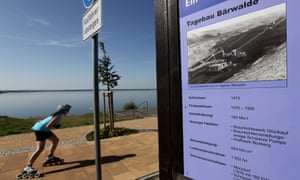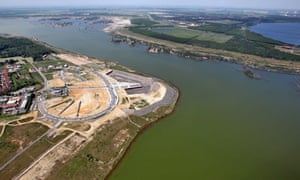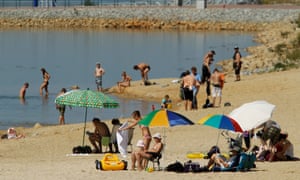https://www.theguardian.com/environment/2014/sep/10/lusatia-lignite-mining-germany-lake-district
Down a single lane road lined by oak trees, about 90 minutes southeast of Berlin, the tiny village of Pritzen sits on a peninsula that juts into Lake Altdöbern. It’s something of a miracle that Pritzen still exists.
Neighboring villages were demolished in the 1980s to make room for an expanding lignite strip mine and Pritzen was slated to be swallowed up next. By 1987 almost all of the 500 or so residents had packed up and left, chased away by the suffocating dust and noise from the mine and the threat of the imminent destruction of their homes.
But then in 1992, after three quarters of the town had already been bulldozed or dismantled, including the centuries-old church and its cemetery, the decision was made to close the mine.
Pritzen still stood, barely, clinging to the edge of a precipice that dropped 70 metres into the mine. Sensing a miraculous change of fortune, villagers began to return. They rebuilt their demolished homes and began replanting their fields and gardens. The steeple from the vanished village of nearby Wolkenhain, its beams dating back to 1485, was erected where the old Pritzen church once stood.
“It is a prominent example of a wounded landscape,” said Katja Sophia Wolf, the head of the Internationale Bauausstellung (IBA) student house in nearby Großräschen and one of the leaders of the Pritzen revitalisation project. “Many houses were destroyed by the mine. The character of Pritzen was changed completely.”
Lignite mining has a long history in this region, called Lusatia. The first mine was started in 1844, along with briquette factories that compacted the lignite into burnable bricks, and related manufacturing and metallurgy industries. A flood of workers arrived for new jobs. Under the East German govenment, the mines were nationalised and expanded. By 1975, Germany had become the world’s largest coal producer, and by the time the country was reunified the industry employed 140,000 people. With the mines came environmental destruction and pollution of the air, ground, and water on a massive scale.
Lignite mining also wreaked havoc among the region’s small villages. According to the Archive of Lost Places, a museum, 136 small and medium towns have been swallowed up by the mines, their residents resettled or evicted. 25,000 people have lost their homes over the years. Just last month, thousands of people protested at Kerkwitz, forming a human chain four-mile long in protest at plans to demolish the Lusatian village for a new lignite mine.
Nevertheless, Lusatian lignite was essential to the German economy and a vital source of regional pride and jobs in the region. “Prior to industrialisation, Lower Lusatia was desperately poor. Only with the energy industry did modest prosperity arrive in our area,” said mayor Frank Szymanski of university city Cottbus.
Then came reunification. Almost all the mines in southern Lusatia were closed. A pressing question arose: what to do with the deep, expansive open pits that scar the area and other messy leftovers from decades of rampant lignite mining? And how to repair the environment? It was a puzzle, but also an opportunity.
To solve it, the government set up the Lausitz and Middle Germany Mining Administrative Company, or LMBV, in 1994. “Our duty is to rehabilitate all the former state-owned mining areas from the GDR period,” said Jörg Schlenstedt, an engineer at LMBV. “The mines were closed down but their legacy was not finalised. Recultivation, rehabilitation, transformation. That’s our job.”
LMBV floods the old mines, turning them into lakes. It treats and cleans water polluted by mining. It replants forests, sells land to be used for fields of solar panels and wind turbines, and encourages agriculture. Even the fish are returning, colonising the artificial lakes by way of new canals that didn’t previously exist or were too acidic to support life. “We can’t bring the area back to its former state, but our aim is to create a useful, natural landscape that provides new chances to the people living here, and also for the next generation,” said Schlenstedt. “All the old natural functions of this area, from before mining, will work again.”
LMBV created 24 artificial lakes in this part of Lusatia and 140 sq km of water surface is newly available for swimming and boating. “That’s one-third more lake area than there was before lignite mining,” said Uwe Steinhuber, a spokesman for the company. The Lusatian lake district is now Europe’s largest artificial lake area.
It has been a long and difficult process. “When we first went to look at one of the mines, it was like a journey to Mars,” said Wolf of IBA, a century-old organisation that deploys artists and architects in formerly industrial areas around Germany. Photos of the excursion show Wolf and her colleagues trudging through an alien landscape, obscured by swirling clouds of grey dust so thick it blocked out the sunlight.
Like LMBV, IBA also works to help this region recover from mining, but in different ways. “IBA didn’t want to hide the industrial heritage, but to show it,” said Sören Hoika, who now runs tours to the completed IBA attractions. “The idea is to build a connection to the past and to the environment.”
IBA came to Lusatia in 2000 and stayed 11 years; 30 projects for new landscapes appeared across the region. They include marinas and sandy beaches that offer incoming tourists boating and watersports opportunities, a former power plant restored for art exhibits and techno parties, towers where tourists can gaze over the former mines, and a former mine purposely left untouched, its low ridges and basin floor slowly being retaken by grass, marshland, insects, and birds.
The rehabilitation process has not been free of hiccups and opponents, and decades of lignite mining have left scars that will take many years to heal. Recently, parts of the River Spree turned rust-orange, a result of the increased iron hydroxide dislodged from the soil by years of mining. The river flows north through the Lusatia mining areas, collecting harmful chemicals along the way. There are fears that the polluted water could reach the protected forest and river haven of Spreewald, and even all the way to Berlin.
Some residents, especially those who have lived here for many years, dislike the changes. “They are very conflicted,” Höika said. “They want to be proud of their past. That was one of the most important things IBA had to learn. How to work with locals, how to celebrate the mining history and at the same time create a nice and interesting new area.”
“Their whole lives they believed this was an area where work is important,” Wolf added. “It was dirty and polluted because it had to be. When they first learned that IBA had brought people to see the mess and the destruction, they were ashamed.”
Still, most residents hope the future belongs to tourism. 500,000 tourists stayed overnight last year in the lake district , according to Marcus Heberle at the tourism board. Beside the new lakes there are hotels, campgrounds, restaurants, and theatres; guides offer tours along an industrial heritage route, showing off the vast briquette factory in Knappenrode and an 11,000-ton conveyor bridge in nearby Lichterfeld. Coal may have scarred this land, but its legacy is driving new life into the region. “By 2025, we hope to have a million guests per year,” Heberle said. “The people want to come.”
For Pritzen, where these changes are less noticeable, the fact that the town is still here – and now a scenic lakeside village – is remarkable. The flooding of the old mine began in 1998 and the water level is still rising. For now, the village remains a sleepy place, as if the trauma of its close brush with destruction still lingers.
“We don’t get too many visitors,” said Ute Dabow as a few Pritzen residents gathered around her mobile bakery, parked at Pritzen’s only intersection, to buy bread and baked goods on a chilly late summer day. The frangrant smell of pine and tilled earth wet from the previous night’s rain wafted across the silent streets, mingling with the aroma of Dabow’s fresh brotchen and pastries. Oak trees shadowed a soccer field overgrown by weeds.
“It’s much better than it once was,” said Herbert Glatz, a retired farmer and lifelong Pritzen resident who was born here in 1935. “The mine was extremely loud. The dirt and dust was so thick it would block out the lights of cars on the streets.” Some people are returning and building new houses, said Herbert’s granddaughter Michaela. “This” – she gestured across the street – “all this is new.”
Around the village, IBA installed a handful of sculptures, turned one of the only old barns that survived the mining era into a place for art exhibits and performances, and set up “The Hand,” a Stonehenge-like circle of concrete pillars built atop a small hill overlooking the lake. Defaced by graffiti and overgrown by waist-high weeds, the sculpture looks somewhat forlorn. But it provides a picturesque panorama of the new landscape.
In the distance, across the glinting waters of the lake, windmills turned slowly. Beside a bike path at the bottom of the hill, the dancing leaves of aspen trees shivered in the breeze. All was quiet except for a faraway rumble of construction machinery, as the lake silently continues to fill, obscuring the scars of the area’s exploited past.
Since you’re here …
… we have a small favour to ask. More people are reading the Guardian than ever but advertising revenues across the media are falling fast. And unlike many news organisations, we haven’t put up a paywall – we want to keep our journalism as open as we can. So you can see why we need to ask for your help. The Guardian’s independent, investigative journalism takes a lot of time, money and hard work to produce. But we do it because we believe our perspective matters – because it might well be your perspective, too.
I appreciate there not being a paywall: it is more democratic for the media to be available for all and not a commodity to be purchased by a few. I’m happy to make a contribution so others with less means still have access to information.Thomasine F-R.
If everyone who reads our reporting, who likes it, helps to support it, our future would be much more secure.






沒有留言:
張貼留言